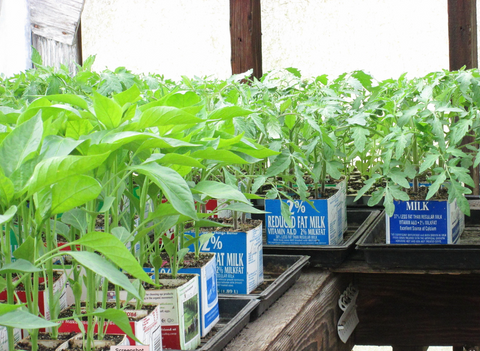
Which Plants Grow Better From Seeds or Transplants?
Share
Q. Which plants are better to grow from seeds and which from starts?
A. I get asked this question aaaa LOT! Here's the short guide-- root crops (carrots, beets, parsnips, radish) don’t like their roots disturbed. So that’s a good rule of thumb. But there are other crops that don’t like it either (e.g. beans, squash, pumpkins, watermelon). And then there are the quick-maturing crops that are just best sown directly in their designated growing spot.
This information is critical! And I have a list at the end of this blog. But read on cuz… it’s important to understand which crops have an advantage being direct sown and which should be transplanted. This will help you avoid slow, weak, and poor-yielding plants. A poor start will lead to a poor season.
Growing or purchasing starts
If you like to purchase plant starts from the greenhouse or even grow your own seedlings, there are some pitfalls, so be aware! I worry about beginning gardeners that might use greenhouse grown (or even home-grown) starter plants and hit the wall. Then they give up when they don’t succeed—thinking, “Even when I buy transplants, I can’t grow a good garden!” Many herbs, veggies, and flowers just DON’T transplant well—and it has nothing to do with how good a gardener you are.
Temperature Shock Pitfall
The shock of going from a super warm greenhouse to cool outside spring temps makes the plant think fall temperatures have arrived. It was so warm and now it’s cool—the plant 'thinks' it’s time to get in gear and go into it’s seed production stage. Result-- it bolts right after transplant, instead of producing the leaves you’re wanting. Have you had that experience?
Cilantro is a good example of this. Even though it’s a ‘cool season’ plant and it grows best in the coolness of spring—the shocking change to outside temps and the cool garden soil causes it to bolt RIGHT NOW-- even if you try to ‘harden’ it off and introduce it to outside temps slowly. Spinach and parsley will do the same thing. Direct seeding into the garden means no temperature changes from hot to cold, which translates to less pre-mature bolting!
Easier to Direct Seed Pitfall
When you visit the greenhouse-- you might find cell packs of fennel, squash, watermelon, melons, cucumbers, radishes and even corn! Just so ya know-- all of those vegetables are so easy to sow directly into your garden or container garden, and honestly, do much better that way.
Direct sowing is not only easier and better in many cases—it’s cheaper! So better to spend your garden budget elsewhere.
Root Bound Pitfall
All transplanted seedlings go through an adjustment period, especially if they have a long taproot that just gets tangled up in a cell pack. A root bound plant won't transplant well.
Even AFTER it adjusts and re-establishes it’s roots—a transplanted plant will often take longer to start blooming! That means a longer time to harvest—often coming in a week or more later than a direct-seeded crop. The transplant shock can really slow them down throughout the season—not JUST in the beginning. Nothing makes up for a good start!
So the next time you pick up that cell pack at the greenhouse and are tempted to spend the money to take a short cut—ask yourself if it’s really a SHORT cut and not the LONG road in disguise!
When you Gotta
However, if you, like me-- and live in a climate with a short growing season, you know there are some plants you just GOTTA start ahead of time. Some crops take a long time to mature and are NOT as sensitive to root disturbance (e.g. peppers, tomatoes, and some flowers and perennials). These are best started indoors to give them a running start to the season.

Maximizing the cool season
Other crops do best in the cool season—like lettuce. We like to start our lettuces, even though it IS possible to direct them. Spring can turn to summer rather quickly here-- especially the last few years-- reducing the lettuce season.
Not sure-- experiment!
In my experience, when you do transplant crops, the plant will literally appear to ‘stand still’ as it’s working underground in root recovery. If you’re working with root sensitive crops, that ‘shock time’ will erase anything you may have gained by starting them. BUT you may have to bend the rules and start some transplant-sensitive crops indoors so you can transplant them out to mature in time before your fall frost.
If you’re tempted to start root sensitive crops ahead of time, try it. But run a fun and informative experiment right beside it. Direct seed some plants at the normal planting time. Transplant your starts when it’s possible and just watch the race! Which starting strategy produced the best results? Take notes and let it inform your strategy next year.
Make it easy on yourself!
Whenever possible, direct sowing seed is preferable. So pay attention to our chart and our recommendation for the seeds we sell. You can find it here-- in Numbers for Mac and Excel for PC. Here's a blog I wrote on these how to use these charts-- to help you get the most from them!
Here's a list of plants that perform best when direct sown in the garden. These are fast growing crops along with the ones that don’t like their roots disturbed, which includes all the root crops.
| Edibles: Arugula Basil Beans Borage Cilantro Corn Cucumber Dill Fennel Melons Peas Pumpkins Beets Carrots Radishes Sorrel Spinach Squash (Summer and Winter) Watermelons |
Ornamentals: Bachelor's buttons Calendula Cleome Cosmos Hollyhocks Hyacinth Bean Morning Glories Poppies Sorghum Sunflowers Sweet Peas Zinnias Wild Chamomile Wild Columbine |
And a bonus! You can find our FREE download of our Green Thumb Playbook-2024 Garden Planner here! Enjoy!
Your garden coach,
Theresa
